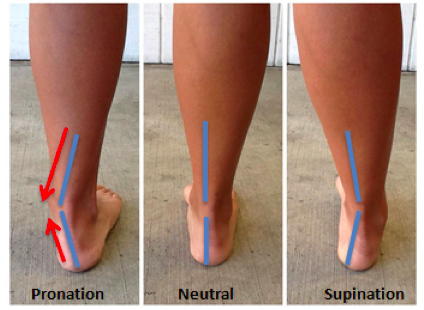 Our feet, like the rest of our body, can slowly wear down as we get older. Due to repetitive motion, years of gradual stress and gait imbalances that are reinforced with every step, our foot structure can slowly shift. This is why some patients present at our clinic with inward turned ankles (we’ve also helped correct outward turned ankles as well).
Our feet, like the rest of our body, can slowly wear down as we get older. Due to repetitive motion, years of gradual stress and gait imbalances that are reinforced with every step, our foot structure can slowly shift. This is why some patients present at our clinic with inward turned ankles (we’ve also helped correct outward turned ankles as well).
This inward turning of the ankles is actually classified as ankle pronation, and understanding pronation can be a little confusing. When an ankle turns inward, it is said to be pronated or overpronated, but pronation is also considered a motion that is performed by the foot during the act of walking. The motion of pronation involves an inward rotation of the lower leg and an outward turning of the foot, which can also contribute to foot arch loss. Still following?
Some pronation is necessary when walking, but if you overpronate you can end up with inward turned ankles and other health issues. In today’s blog, we take a closer look at what these inward turned ankles mean for your feet, and how a foot specialist can help you treat them.
Pronated Ankles
Pronated ankles may not seem like all that big of a deal, especially since they aren’t typically painful like other foot conditions. You may feel some discomfort after being on your feet for an extended period of time, but pronated feet aren’t likely to cause significant pain in and of themselves. That being said, overpronated feet can contribute to the onset of other painful conditions, including but not limited to:
- Shin Splints
- Posterior Tibial Tendonitis
- Plantar Fasciitis
- Bunions
- Sciatica
- Lower Back Pain
- Hip Pain
- Knee Pain
So what should you do if you notice that your ankles appear to be bending inwards? Even though they may not be painful at the moment, if you keep doing the same things that led to the condition in the first place, odds are it’s only going to get worse. And when this happens, the likelihood of other conditions developing skyrockets. So instead of ignoring the inward turned ankles, you should have them examined by a foot and ankle specialist.
The easiest way to treat an inward bowing of the ankles, or to at least shift how pressure is dispersed and prevent the condition from getting worse, is by getting set up with an orthotic insert. Your foot specialist can take a look at your feet and use some diagnostic tools in their arsenal to figure out which type of insert would help shift how stress is displaced in your foot so that the pronation doesn’t continue. Custom orthotics help to eliminate the faulty mechanics in your gait that contribute to this overpronation.
Some foot specialists may also order a few sessions of physical therapy. This will help to build up muscles in the foot and ankle that may need to handle more pressure as orthotics shift how stress is displaced in the area. Coupled together, orthotic inserts and simple physical therapy exercises do wonders for helping prevent bigger problems caused by overpronated ankles.